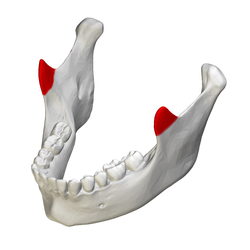
Back ناتئ إكليلي للفك السفلي Arabic Apòfisi coronoide Catalan Apófisis coronoides mandibular Spanish Processus coronoïde de la mandibule French הזיז הווי של הלסת התחתונה HE Állkapocs kampónyúlványa Hungarian
This article may be too technical for most readers to understand. (December 2019) |
| Coronoid process of the mandible | |
|---|---|
 Position of coronoid process in skull (shown in red) | |
 Position of coronoid process in mandible (shown in red) | |
| Details | |
| Part of | Mandible |
| System | Skeletal |
| Identifiers | |
| Latin | processus coronoideus mandibulae |
| TA98 | A02.1.15.032 |
| TA2 | 869 |
| FMA | 52833 |
| Anatomical terms of bone | |
In human anatomy, the mandible's coronoid process (from Greek korōnē, denoting something hooked) is a thin, triangular eminence, which is flattened from side to side and varies in shape and size. Its anterior border is convex and is continuous below with the anterior border of the ramus. Its posterior border is concave and forms the anterior boundary of the mandibular notch. The lateral surface is smooth, and affords insertion to the temporalis and masseter muscles. Its medial surface gives insertion to the temporalis, and presents a ridge which begins near the apex of the process and runs downward and forward to the inner side of the last molar tooth.
Between this ridge and the anterior border is a grooved triangular area, the upper part of which gives attachment to the temporalis, the lower part to some fibers of the buccinator.